Article Figures & Data
Tables
Cancer type and method of screening Per 100,000 person-years Harms of interventions Deaths from cancer Deaths averted by screening Deaths not averted by screening Breast cancera Mammography every 2 years False-positive results Overdiagnosis, overtreatment
Radiation exposureAge 39–49 34 4 30 (88%) Age 50–59 54 8 46 (85%) Age 60–69 65 21 44 (68%) Age 70–74 62 13 49 (79%) Age 50–69 58 13 45 (78%) Colon cancerb One-time flexible sigmoidoscopy 44 12 32 (73%) Complications of procedure
Overdiagnosis, overtreatmentGuaiac fecal occult blood test once a year 44 4 40 (91%) False-positive results
Overdiagnosis, overtreatmentColonoscopy every 10 years8 69 9 60 (87%) Perforation of the colon Prostate cancerc Prostate-specific antigen test once a year 48 10 38 (79%) False-positive results
Overdiagnosis, overtreatmentLung cancerd Low-dose computed tomography once a year 309 59 250 (81%) False-positive results
Overdiagnosis, overtreatment↵a Breast cancer numbers are based on risk ratio in Table 5 of reference 2.
↵b Effects of sigmoidoscopy are based on 4 large randomized trials with 11- to 12-year follow-up. Colon cancer mortality without screening is calculated as the average mortality of the control groups in the 4 randomized trials (Table 1 of reference 7). Incident rate ratio of 0.73 was used to calculate colon cancer deaths avoided with screening with sigmoidoscopy. Effects of guaiac fecal occult blood testing are based on 5 randomized trials with 11- to 30-year follow-up (also Table of reference 7). Relative risk of 0.91 was used to calculate effects of screening. The US Preventive Services Task Force (USPSTF) estimated the relative risk of 0.91 after 19.5 years of screening and 0.78 after 30 years of screening. Colonoscopy effects are based on Table 3 and Table 4 of referenced modeling study representing 40-year follow-up of 1,000 men and women.8 The modeling study is designed to compare different screening modalities; all participants are screened regardless of life expectancy, and calculations are based on 100% adherence to screening. Therefore, numbers cannot be directly compared with other cancer screening programs.
↵c Prostate cancer numbers are based on the table in reference 3 on 13-year follow-up of 1,000 men invited to screening.
↵d Lung cancer numbers are based on National Lung Screening Trial of lung cancer mortality and relative risk of 0.81 from USPSTF meta-analysis.






